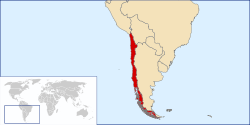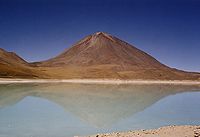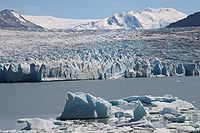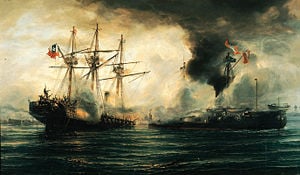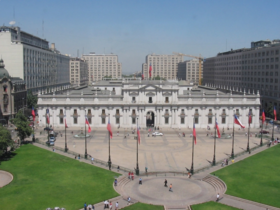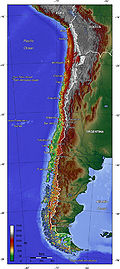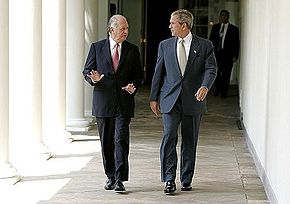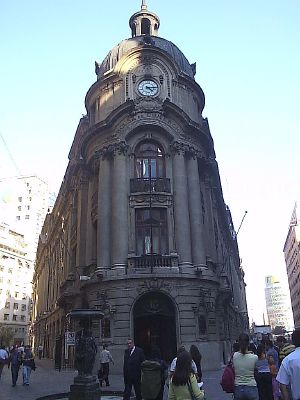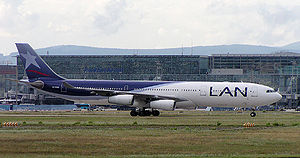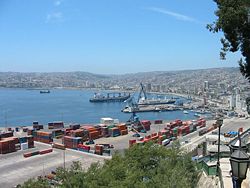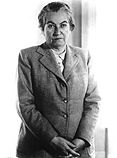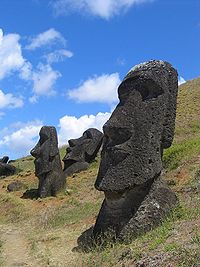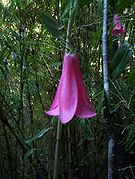Difference between revisions of "Chile" - New World Encyclopedia
Vicki Phelps (talk | contribs) |
Vicki Phelps (talk | contribs) m (→Culture) |
||
| Line 224: | Line 224: | ||
[[Image:Chile-demography.png|thumb|right|200px|Population of Chile from 1835, projected up to 2050 (INE)]] | [[Image:Chile-demography.png|thumb|right|200px|Population of Chile from 1835, projected up to 2050 (INE)]] | ||
| − | Chile's growth has been declining since the early 1990s, due to a decreasing | + | Chile's growth has been declining since the early 1990s, due to a decreasing birthrate. By 2050 the population is expected to reach approximately 20.2 million. About 85 percent of the country's population lives in urban areas, with 40 percent living in Greater Santiago. |
===Racial structure=== | ===Racial structure=== | ||
| − | The bulk of the Chilean population | + | The bulk of the Chilean population are mestizo quality, descendants of colonial [[Spain|Spanish]] immigrants and [[Amerindian]] females (including the Atacameños, Diaguitas, Picunches, Araucanians or Mapuches, Huilliches, Pehuenches, and Cuncos. |
| − | Chile's ethnic structure can be classified as 30 percent white, 5 percent Native American and 65 percent predominantly white mestizos. Whites are mostly Spanish in origin (mainly Castilians, Andalusians, and [[Basques]]), and to a much lesser degree from Chile's various waves of immigrants | + | Chile's ethnic structure can be classified as 30 percent white, 5 percent Native American, and 65 percent predominantly white mestizos. Whites are mostly Spanish in origin (mainly Castilians, Andalusians, and [[Basques]]), and to a much lesser degree from Chile's various waves of immigrants. The black population was always scant, reaching a high of 25,000 during the colonial period; its racial contribution is less than 1 percent. The current Native American population is relatively small (see below) according to the censuses; their numbers are augmented when one takes into consideration those that are physically similar and those that are linguistically or socially thought to belong to them. |
=== Indigenous communities === | === Indigenous communities === | ||
| Line 245: | Line 245: | ||
|align=left|Colla||3.198||0,02%||align=left|Yámana||1.685||0,01% | |align=left|Colla||3.198||0,02%||align=left|Yámana||1.685||0,01% | ||
|} | |} | ||
| − | In the 1992 Chilean census, a total of 10.5% of the total population surveyed declared themselves indigenous, irrespective of whether they currently practiced or spoke a native culture and language; almost one million people (9.7% of the total) declared themselves Mapuche, 0.6% declared to be Aymara, and | + | In the 1992 Chilean census, a total of 10.5% of the total population surveyed declared themselves indigenous, irrespective of whether they currently practiced or spoke a native culture and language; almost one million people (9.7% of the total) declared themselves [[Mapuche]], 0.6% declared to be Aymara, and 0.2% reported as Rapanui. |
At the 2002 census, only indigenous people that still practiced or spoke a native culture and language were surveyed: 4.6% of the population (692,192 people) fit that description; of these, 87.3% declared themselves Mapuche. | At the 2002 census, only indigenous people that still practiced or spoke a native culture and language were surveyed: 4.6% of the population (692,192 people) fit that description; of these, 87.3% declared themselves Mapuche. | ||
| Line 251: | Line 251: | ||
=== Immigration === | === Immigration === | ||
| − | Relative to its overall population, Chile never experienced any large scale wave of immigrants. The total number of immigrants to Chile, both originating from other Latin American countries and all other (mostly European) countries, never surpassed 4 | + | Relative to its overall population, Chile never experienced any large-scale wave of immigrants. The total number of immigrants to Chile, both originating from other Latin American countries and all other (mostly European) countries, never surpassed 4 percent of its total population. This is not to say that immigrants were not important to the evolution of Chilean society and the Chilean nation. Basque families who migrated to Chile in the eighteenth century vitalized the economy and joined the old Castilian aristocracy to become the political elite that still dominates the country. Some non-Spanish European immigrants arrived in Chile - mainly to the northern and southern extremities of the country - during the nineteenth and twentieth centuries, including [[United Kingdom|English, [[Germany|Germans]], [[Ireland|Irish]], [[Italy|Italians]], [[France|French]], [[Croatia]]ns, and other former [[Yugoslavia]]ns. The prevalence of non-Hispanic European surnames among the governing body of modern Chile testifies to their disproportionate contribution. Also worth mentioning are the [[Korea]]n and [[Palestine|Palestinian]] communities, the latter being the largest colony of that people outside of the Arab world. The volume of immigrants from neighboring countries to Chile during those same periods was similar. |
| − | + | During the last decade immigration to Chile has doubled, originating primarily from [[Argentina]], [[Bolivia]], and [[Peru]], while emigration of Chileans has decreased. | |
== Culture == | == Culture == | ||
| Line 261: | Line 261: | ||
[[Image:Neruda1.PNG|113px|thumb||left|Pablo Neruda, Nobel Prize for Literature (1971)]] | [[Image:Neruda1.PNG|113px|thumb||left|Pablo Neruda, Nobel Prize for Literature (1971)]] | ||
| − | Northern Chile was an important center of culture in the medieval and early modern [[Inca]] | + | Northern Chile was an important center of culture in the medieval and early modern [[Inca Civilization|Inca civilization]], while the central and southern regions were areas of [[Mapuche]] cultural activity. Following their conquest and during the early Republican period, the culture was dominated by the Spanish. Other European influences, primarily English and French, began in the nineteenth century and have continued to this day. |
The national [[dance]] is the ''cueca''. Another form of traditional Chilean song, though not a dance, is the ''tonada''. Arising from music imported by the Spanish colonists, it is distinguished from the cueca by an intermediate melodic section and a more prominent melody. In the mid-1960s native musical forms were revitalized by the Parra family with the Nueva Canción Chilena, which was associated with political activists and reformers, and by the folk singer and researcher on folklore and Chilean ethnography Margot Loyola. | The national [[dance]] is the ''cueca''. Another form of traditional Chilean song, though not a dance, is the ''tonada''. Arising from music imported by the Spanish colonists, it is distinguished from the cueca by an intermediate melodic section and a more prominent melody. In the mid-1960s native musical forms were revitalized by the Parra family with the Nueva Canción Chilena, which was associated with political activists and reformers, and by the folk singer and researcher on folklore and Chilean ethnography Margot Loyola. | ||
| − | Chileans call their country ''país de poetas'' (land of poets). [[Gabriela Mistral]] was the first Chilean to win a [[Nobel Prize for Literature | + | Chileans call their country ''país de poetas'' (land of poets). [[Gabriela Mistral]] was the first Chilean to win a [[Nobel Prize]] for Literature (1945). Chile's most famous poet, however, is Pablo Neruda, who also won the Nobel Prize for Literature (1971) and is world renowned for his extensive works on romance, nature, and politics. |
=== Tourism === | === Tourism === | ||
[[Image:Moai Rano raraku.jpg|thumb|200px|Moais at Easter Island]] | [[Image:Moai Rano raraku.jpg|thumb|200px|Moais at Easter Island]] | ||
| − | + | [[Tourism]] has become one of the main sources of revenue; in 2005, tourism grew by 13.6 percent, generating more than $1.5 billion (equivalent to 1.33 percent of the national GDP). | |
| − | [[Image:Renaca4.jpg|thumb|250px| | + | [[Image:Renaca4.jpg|thumb|250px|right|Panoramic view of Reñaca, Viña del Mar]] |
| − | The main attractions for tourists are places of natural beauty situated in the extreme zones of the country: San Pedro de Atacama, in the north, is very popular with foreign tourists who arrive to admire the Incaic architecture and the altiplano lakes of the Valley of the Moon. | + | The main attractions for tourists are places of natural beauty situated in the extreme zones of the country: |
| + | * San Pedro de Atacama, in the north, is very popular with foreign tourists who arrive to admire the Incaic architecture and the altiplano lakes of the Valley of the Moon. | ||
| + | * Putre, also in the north, has Chungará Lake, as well as the Parinacota and the Pomerape volcanoes, with altitudes of 6,348 m and 6,222 m, respectively. * Throughout the central [[Andes]] there are many ski resorts of international repute. | ||
| + | * In the south, the main tourist sites are Chiloé island, [[Patagonia]], the San Rafael Lagoon, with its many glaciers, and the Towers of Paine national park. | ||
| + | * The central port city of Valparaíso, with its unique architecture, is also popular. Due to its proximity to Santiago, the coast of the Valparaíso Region, with its many beach resorts, receives the largest amount of local tourists. | ||
| + | * [[Easter Island]] in the [[Pacific Ocean]] is probably the main Chilean tourist destination. | ||
| + | * Viña del Mar, Valparaíso's northern affluent neighbor, is popular due to its beaches, [[casino]], and its annual song festival, the most important musical event in Latin America. | ||
| − | + | === Language === | |
| + | The official language is Spanish, though it is difficult for foreigners to understand due to the dropping of final syllables and 's' sounds, the very soft pronunciation of some consonants, and the high levels of slang employed, particularly in Santiago and the surrounding areas. Chileans also tend to speak much faster than natives of neighboring countries. | ||
| − | + | [[Image:Lapageria rosea.jpg|135px|thumb|A red copihue (Chilean bellflower), | |
| − | + | the national flower, which grows in the woods of southern Chile.]] | |
| − | |||
| − | |||
| − | |||
| − | |||
| − | |||
| − | |||
| − | [[Image:Lapageria rosea.jpg|135px|thumb|A red copihue | ||
| − | |||
| − | |||
| − | |||
| − | |||
| − | |||
===Religion=== | ===Religion=== | ||
| − | Chile is a traditionally Roman Catholic nation, with an estimated 70 percent of Chileans belonging to that church. Other denominations or groupings include: Protestant or evangelical (15.1%), Jehovah's Witnesses (1%), the Church of Jesus Christ of Latter-day Saints (0.9%), Jewish (0.1%), atheist or agnostic (8.3%), and other (4.4%). Less than 0.1% are either Orthodox or | + | Chile is a traditionally [[Roman Catholic]] nation, with an estimated 70 percent of Chileans belonging to that church. Other denominations or groupings include: [[Protestant]] or evangelical (15.1%), [[Jehovah's Witnesses]] (1%), the [[Church of Jesus Christ of Latter-day Saints]] (0.9%), [[Jewish]] (0.1%), atheist or agnostic (8.3%), and other (4.4%). Less than 0.1% are either Orthodox or [[Muslim]]. |
| − | |||
| − | |||
| − | |||
| − | |||
| − | |||
| − | |||
| − | |||
| − | |||
| − | |||
| − | |||
| − | |||
| − | |||
| − | |||
| − | |||
| − | |||
| − | |||
| − | |||
| − | |||
| − | |||
| − | |||
| − | |||
| − | |||
| − | |||
| − | |||
| − | |||
| − | |||
| − | |||
| − | |||
| − | |||
| − | |||
| − | |||
| − | |||
| − | |||
| − | |||
| − | |||
| − | |||
| − | |||
| − | |||
| − | |||
| − | |||
| − | |||
| − | |||
| − | |||
| − | |||
| − | |||
| − | |||
| − | |||
| − | |||
| − | |||
| − | |||
| − | |||
| − | |||
| − | |||
| − | |||
| − | |||
| − | |||
| − | |||
== References == | == References == | ||
{{reflist|2}} | {{reflist|2}} | ||
| − | == | + | == Sources and Further reading == |
| − | * [http://www.state.gov/r/pa/ei/bgn/1981.htm | + | * Rector, John. 2003. ''The History of Chile''. Westport, CT: Greenwood Press. ISBN 0313317593 |
| − | * [http://lcweb2.loc.gov/frd/cs/cltoc.html Library of Congress | + | * [http://www.state.gov/r/pa/ei/bgn/1981.htm] Background Notes: Chile, ''Department of State'', Retrieved November 10, 2007. |
| + | * [http://lcweb2.loc.gov/frd/cs/cltoc.html] ''Library of Congress Country Profile'' | ||
* [http://www.britannica.com/nations/Chile Encyclopaedia Britannica, Chile - Country Page] | * [http://www.britannica.com/nations/Chile Encyclopaedia Britannica, Chile - Country Page] | ||
| − | * [https://www.cia.gov/library/publications/the-world-factbook/geos/ci.html | + | * [https://www.cia.gov/library/publications/the-world-factbook/geos/ci.html] ''CIA World Factbook'' |
| − | |||
== External links == | == External links == | ||
| − | + | ===Official=== | |
| − | + | * [http://www.gobierno.cl/ Gobierno] - Government ([http://www.chileangovernment.cl/] (Spanish) | |
| − | |||
| − | ===Official | ||
| − | * [http://www.gobierno.cl/ Gobierno] - Government ([http://www.chileangovernment.cl/ | ||
** [http://www.presidencia.gov.cl/ Presidencia] - Presidency ([http://www.presidencyofchile.cl/ English version]) | ** [http://www.presidencia.gov.cl/ Presidencia] - Presidency ([http://www.presidencyofchile.cl/ English version]) | ||
** [http://www.interior.cl/ Ministerio del Interior] - Interior Ministry | ** [http://www.interior.cl/ Ministerio del Interior] - Interior Ministry | ||
| Line 382: | Line 317: | ||
===General information=== | ===General information=== | ||
| − | |||
* [http://www.atacamachile.cl Atacama Chile] | * [http://www.atacamachile.cl Atacama Chile] | ||
*[http://dmoz.org/Regional/South_America/Chile Open Directory Project - ''Chile''] directory category | *[http://dmoz.org/Regional/South_America/Chile Open Directory Project - ''Chile''] directory category | ||
| − | + | * [http://www.chipsites.com/ Chile Information, Travel, Living Abroad, Human Rights & Environment] ''Chile Information Project'' | |
| − | * [http://www.chipsites.com/ Chile Information, Travel, Living Abroad, Human Rights & Environment] | + | * [http://www.tcgnews.com/santiagotimes/ Chile News] ''Santiago Times'' |
| − | * [http://www.tcgnews.com/santiagotimes/ Chile News] | + | * [http://lanic.utexas.edu/la/chile/] ''Latin American Network (Information Center)'' |
| − | * [http://lanic.utexas.edu/la/chile/ | + | * [http://www.coha.org] ''Council of Hemispheric Affairs''. |
| − | * [http://www.coha.org Council of Hemispheric Affairs | + | * [http://www.chileangovernment.cl/index.php?option=com_content&task=view&id=65&Itemid=41 Invest in Chile] ''Chilean Government'' |
| − | + | * [http://www.chilebosque.cl/index_en.html] Native flora species | |
| − | * [http://www.chileangovernment.cl/index.php?option=com_content&task=view&id=65&Itemid=41 Invest in Chile] | ||
| − | * [http://www.chilebosque.cl Native flora species | ||
[[Category:Geography]] | [[Category:Geography]] | ||
Revision as of 22:59, 10 November 2007
| República de Chile Republic of Chile | |||||
| |||||
| Motto: Por la Razón o la Fuerza (Spanish: "By right or might") | |||||
| Anthem: Himno Nacional de Chile | |||||
| Capital | Santiago1 33°26′S 70°40′W | ||||
|---|---|---|---|---|---|
| Largest city | capital | ||||
| Official languages | Castilian | ||||
| Government | Democratic republic | ||||
| - President | Michelle Bachelet | ||||
| Independence | from Spain | ||||
| - First National Government Junta |
September 18 1810 | ||||
| - Declared | February 12 1818 | ||||
| - Recognized | April 25 1844 | ||||
| Area | |||||
| - Total | 756,950 km² (38th) 292,183 sq mi | ||||
| - Water (%) | 1.07² | ||||
| Population | |||||
| - June 2007 estimate | 16,598,074 | ||||
| - 2002 census | 15,116,435 | ||||
| - Density | 22/km² 57/sq mi | ||||
| GDP (PPP) | 2006 estimate | ||||
| - Total | US$ 212.671 billion | ||||
| - Per capita | US$ 12,983 | ||||
| HDI (2004) | |||||
| Currency | Peso (CLP)
| ||||
| Time zone | n/a (UTC-4) | ||||
| - Summer (DST) | n/a (UTC-3) | ||||
| Internet TLD | .cl | ||||
| Calling code | +56 | ||||
Chile, officially the Republic of Chile, is a country in South America occupying a long and narrow coastal strip wedged between the Andes mountains and the Pacific Ocean. The Pacific forms the country's entire western border, with Peru to the north, Bolivia to the northeast, Argentina to the east, and the Drake Passage at the country's southernmost tip. Chile claims 1,250,000 square kilometers of territory in Antarctica.
Geography
A long and narrow coastal Southern Cone country on the west side of the Andes Mountains, Chile stretches over 2,880 miles (4,630 km) north to south, but only 265 miles ( 430 km) at its widest point east to west. This encompasses a remarkable variety of landscapes.
At 292,240 mi² (756,950 km²), Chile is the world's 38th-largest country. It is comparable in size to Zambia and is about twice the size of Japan.
The northern Atacama Desert contains great mineral wealth, primarily copper and nitrates. The relatively small Central Valley, which includes Santiago, dominates the country in terms of population and agricultural resources. This area also is the historical center from which Chile expanded in the late nineteenth century, when it integrated the northern and southern regions.
Southern Chile is rich in forests and grazing lands and features a string of volcanoes and lakes. The southern coast is a labyrinth of fjords, inlets, canals, twisting peninsulas, and islands. The Andes Mountains are located on the eastern border. Chile also claims 482,628 square miles (1,250,000 sq km) of Antarctica as part of its territory. However, this latter claim is suspended under the terms of the Antarctic Treaty, of which Chile is signatory.
Chile controls Easter Island and Sala y Gómez Island, the easternmost islands of Polynesia, which it incorporated to its territory in 1888, and Robinson Crusoe Island, more than 600 kilometers (375 mi) from the mainland, in the Juan Fernández archipelago. Easter Island is nowadays a province of Chile. Also controlled but only temporally inhabited (by some local fishermen) are the small islands of Sala y Gómez, San Ambrosio, and San Felix, these islands are notable because they extend Chile's claim to territorial waters out from its coast into the Pacific.
History
Etymology
There are various theories about the origin of the word Chile. According to one theory the Incas of Peru, who had failed to conquer the Araucanians, called the valley of the Aconcagua "Chili" by corruption of the name of a tribal chief ("cacique") called Tili, who ruled the area at the time of the Incan conquest. Another theory points to the similarity of the valley of the Aconcagua with that of the Casma Valley in Peru, where there was a town and valley named Chili. Other theories say Chile may derive its name from the indigenous Mapuche word chilli, which may mean "where the land ends," "the deepest point of the earth,," or "sea gulls;" or from the Quechua chin, "cold," or the Aymara tchili, meaning "snow." Another meaning attributed to chilli is the onomatopoeic cheele-cheele—-the Mapuche imitation of a bird call. The Spanish conquistadors who heard about this name from the Incas and the few survivors of Diego de Almagro's first Spanish expedition south from Peru in 1535-1536 called themselves the "men of Chilli."
Prehistory
About ten thousand years ago, migrating Native Americans settled in fertile valleys and along the coast of what is now Chile. The Incas briefly extended their empire into what is now northern Chile, but the area's barrenness prevented extensive settlement.
European colonization
In 1520, while attempting to circumnavigate the earth, the Portuguese explorer Ferdinand Magellan discovered the southern passage now named after him, the Strait of Magellan. The next Europeans to reach Chile were Diego de Almagro and his band of Spanish conquistadors, who came from Peru in 1535 seeking gold. The Spanish encountered hundreds of thousands of Native Americans from various cultures in the area that modern Chile now occupies. These cultures supported themselves principally through slash-and-burn agriculture and hunting. The conquest of Chile began in earnest in 1540 and was carried out by Pedro de Valdivia, one of Francisco Pizarro's lieutenants, who founded the city of Santiago. Although the Spanish did not find the extensive gold and silver they sought, they recognized the agricultural potential of Chile's central valley, and Chile became part of the Viceroyalty of Peru.
Conquest of the land that is today called Chile took place only gradually, and the Europeans suffered repeated setbacks at the hands of the local population. A massive Mapuche insurrection that began in 1553 resulted in Valdivia's death and the destruction of many of the colony's principal settlements. Subsequent major insurrections took place in 1598 and in 1655. Each time the Mapuche and other native groups revolted, the southern border of the colony was driven northward. The abolition of slavery in 1683 defused tensions on the frontier between the colony and the Mapuche land to the south, and permitted increased trade between colonists and the Mapuche.
The drive for independence from Spain was precipitated by usurpation of the Spanish throne by Napoleon Bonaparte's brother Joseph in 1808. A national junta in the name of Ferdinand—-heir to the deposed king—-was formed in 1810 and proclaimed Chile an autonomous republic within the Spanish monarchy. A movement for total independence soon won a wide following. Spanish attempts to re-impose arbitrary rule during what was called the "Reconquista" led to a prolonged struggle.
Republic
Intermittent warfare continued until 1817, when an army led by Bernardo O'Higgins, Chile's most renowned patriot, and José de San Martín, hero of the Argentine war of independence, crossed the Andes into Chile and defeated the royalists. On February 12, 1818, Chile was proclaimed an independent republic. The political revolt brought little social change, however, and nineteenth-century Chilean society preserved the essence of the stratified colonial social structure, which was greatly influenced by family politics and the Roman Catholic Church. A strong presidency eventually emerged, but wealthy landowners remained extremely powerful.
Toward the end of the nineteenth century, the government in Santiago consolidated its position in the south by ruthlessly suppressing the Mapuche during the occupation of Araucanía. In 1881, it signed a treaty with Argentina confirming Chilean sovereignty over the Strait of Magellan. As a result of the War of the Pacific with Peru and Bolivia (1879–1883), Chile expanded its territory northward by almost one-third, eliminating Bolivia's access to the Pacific, and acquired valuable nitrate deposits, the exploitation of which led to an era of national affluence.
The Chilean civil war in 1891 brought about a redistribution of power between the president and Congress, and Chile established a parliamentary-style democracy. However, the civil war had also been a contest between those who favored the development of local industries and powerful Chilean banking interests, particularly the House of Edwards, which had strong ties to foreign investors. Hence the Chilean economy partially degenerated into a system protecting the interests of a ruling oligarchy. By the 1920s, the emerging middle and working classes were powerful enough to elect a reformist president, Arturo Alessandri Palma, whose program was frustrated by a conservative congress. Alessandri Palma's reformist tendencies were partly tempered later by an admiration for some elements of Mussolini's Italian Corporate State. In the 1920s, Marxist groups with strong popular support arose.
A military coup led by General Luis Altamirano in 1924 set off a period of political instability that lasted until 1932. The longest lasting of the ten governments between those years was that of General Carlos Ibáñez del Campo, who briefly held power in 1925 and then again between 1927 and 1931 in what was a de facto dictatorship, although not really comparable in harshness or corruption to the type of military dictatorship that has often bedeviled the rest of Latin America, and certainly not comparable to the violent and repressive regime of Augusto Pinochet decades later. By relinquishing power to a democratically elected successor, Ibáñez del Campo retained the respect of a large enough segment of the population to remain a viable politician for more than thirty years, despite the vague and shifting nature of his ideology.
When constitutional rule was restored in 1932, a strong middle-class party, the Radicals, emerged and became the key force in coalition governments for the next twenty years. During the period of Radical Party dominance (1932–1952), the state increased its role in the economy. In 1952, voters returned Ibáñez del Campo, now considered a sort of Chilean Perón, to office for another six years. Jorge Alessandri succeeded Ibáñez del Campo in 1958, bringing Chilean conservatism back into power democratically for another term.
The 1964 presidential election of Christian Democrat Eduardo Frei Montalva by an absolute majority initiated a period of major reform. Under the slogan "Revolution in Liberty," the Frei administration embarked on far-reaching social and economic programs, particularly in education, housing, and agrarian reform, including unionization of agricultural workers. By 1967, however, Frei encountered increasing opposition from leftists, who charged that his reforms were inadequate, and from conservatives, who found them excessive. At the end of his term, Frei had accomplished many noteworthy objectives, but he had not fully achieved his party's ambitious goals.
In 1970, Senator Salvador Allende, a Marxist physician and member of Chile's Socialist Party, who headed the "Popular Unity" (UP for "Unidad Popular") coalition of the Socialist, Communist, Radical, and Social-Democratic parties, along with dissident Christian Democrats, the Popular Unitary Action Movement (MAPU), and the Independent Popular Action, won a plurality of votes in a three-way contest. Despite pressure from the government of the United States, the Chilean Congress, keeping with tradition, conducted a runoff vote between the leading candidates, Allende and former president Jorge Alessandri and chose Allende by a vote of 153 to 35. Frei refused to form an alliance with Alessandri to oppose Allende, on the grounds that the Christian Democrats were a workers party and could not make common cause with the oligarchs.
Allende's program included advancement of workers' interests; a thorough implementation of agrarian reform; the reorganization of the national economy into socialized, mixed, and private sectors; a foreign policy of "international solidarity" and national independence; and a new institutional order (the "people's state" or "poder popular"), including the institution of a unicameral congress. The UP platform also called for nationalization of foreign (U.S.) ownership of Chile's major copper mines.
An economic depression that began in 1967 peaked in 1970, exacerbated by capital flight, plummeting private investment, and withdrawal of bank deposits by those opposed to Allende's socialist program. Production fell and unemployment rose. Allende adopted measures including price freezes, wage increases, and tax reforms, which had the effect of increasing consumer spending and redistributing income downward. Joint public-private public works projects helped reduce unemployment. Much of the banking sector was nationalized. Many enterprises within the copper, coal, iron, nitrate, and steel industries were expropriated, nationalized, or subjected to state intervention. Industrial output increased sharply and unemployment fell during the Allende administration's first year.
Other reforms undertaken during the early Allende period included redistribution of millions of hectares of land to landless agricultural workers as part of the agrarian reform program, giving the armed forces an overdue pay increase, and providing free milk to children. The Indian Peoples Development Corporation and the Mapuche Vocational Institute were founded to address the needs of Chile's indigenous population.
The nationalization of U.S. and other foreign-owned companies led to increased tensions with the United States. The Nixon administration brought international financial pressure to bear to restrict economic credit to Chile. Simultaneously, the CIA funded opposition media, politicians, and organizations, helping to accelerate a campaign of domestic destabilization. By 1972, the economic progress of Allende's first year had been reversed and the economy was in crisis. Political polarization increased, and large mobilizations of both pro- and anti-government groups became frequent, often leading to clashes.
By early 1973, inflation was out of control. The crippled economy was further battered by prolonged and sometimes simultaneous strikes by physicians, teachers, students, truck owners, copper workers, and the small business class.
A military coup overthrew Allende on September 11, 1973. As the armed forces bombarded the presidential palace, Allende reportedly committed suicide. A military government, led by General Augusto Pinochet Ugarte, took over. The first years of the regime were marked by serious human rights violations. At least a thousand people were executed during the first six months of Pinochet in office, and at least two thousand more were killed during the next sixteen years, as reported by the Rettig Report. Some 30,000 fled the country, and tens of thousands of people were detained and tortured, as investigated by the 2004 Valech Commission. A new constitution was approved by a highly irregular and undemocratic plebiscite, characterized by the absence of registration lists, on September 11, 1980, and General Pinochet became president for an eight-year term.
In the late 1980s, the regime gradually permitted greater freedom of assembly, speech, and association, to include trade union and limited political activity. The right-wing military government pursued free market economic policies. During Pinochet's nearly seventeen years in power, Chile moved away from state involvement toward a largely free-market economy that saw an increase in domestic and foreign private investment, although the copper industry and other important mineral resources were not returned to foreign ownership. In a plebiscite on October 5, 1988, General Pinochet was denied a second term as president. Chileans elected a new president and the majority of members of a two-chamber congress on December 14, 1989. Christian Democrat Patricio Aylwin, the candidate of a coalition of seventeen political parties, received an absolute majority of votes (55 percent). Aylwin served from 1990 to 1994, in what was considered a transition period.
In December 1993, Christian Democrat Eduardo Frei Ruiz-Tagle, the son of previous president Eduardo Frei Montalva, led the coalition to victory. He was succeeded in 2000 by Socialist Ricardo Lagos, who won the presidency in a runoff election against Joaquín Lavín of the rightist Alliance for Chile. In January 2006 Chileans elected their first woman president, Michelle Bachelet Jeria, of the Socialist Party. She was sworn in on March 11, 2006, extending coalition governance for another four years.
Politics
Chile's constitution was approved in a highly irregular national plebiscite in September 1980, under the military government of Augusto Pinochet. It entered into force in March 1981. After Pinochet's defeat in the 1988 plebiscite, the constitution was amended to ease provisions for future amendments to the Constitution. In September 2005, President Ricardo Lagos signed into law several constitutional amendments passed by Congress. These include eliminating the positions of appointed senators and senators for life, granting the president authority to remove the commanders-in-chief of the armed forces, and reducing the presidential term from six to four years.
The presidential elections of 2005 was Chile’s fourth since the end of the Pinochet era. All four have been judged free and fair. The president is constitutionally barred from serving consecutive terms.
Chile's bicameral Congress has a 38-seat Senate and a 120-member Chamber of Deputies. Senators serve for eight years with staggered terms, while deputies are elected every four years. The Congress is located in the port city of Valparaíso, about 84 miles (140 km) west of the capital, Santiago.
Chile's congressional elections are governed by a binomial system that rewards large representations. Therefore, there are only two Senate and two Deputy seats apportioned to each electoral district; parties are forced to form wide coalitions and, historically, the two largest coalitions (Concertación and Alianza) split most of the seats in a district. Only if the leading coalition ticket outpolls the second-place coalition by a margin of more than 2-to-1 does the winning coalition gain both seats. In 2005, both leading parties lost representation in favor of their respective allies, the Socialist Party (which became the biggest party in the Concertación bloc) and National Renewal in the right-wing alliance. The Communist Party again failed to gain any seats in the election.
Chile's judiciary is independent and includes a court of appeal, a system of military courts, a constitutional tribunal, and the Supreme Court. In June 2005, Chile completed a nationwide overhaul of its criminal justice system. The reform replaced inquisitorial proceedings with an adversarial system more similar to that of the United States.
Administrative divisions
Chile is divided into fifteen regions, each of which is headed by an intendant appointed by the president. Every region is further divided into provinces, with a provincial governor also appointed by the president. Finally, each province is divided into communes, which are administered by municipalities, each with its own mayor and councilmen elected by their inhabitants for four years.
Foreign relations
Since its return to democracy in 1990, Chile has been an active participant in the international political arena. Chile completed a two-year non-permanent position on the UN Security Council in January 2005. José Miguel Insulza, a Chilean national, was elected Secretary General of the Organization of American States in May 2005. Chile is an active member of the UN family of agencies and participates in UN peacekeeping activities. Chile hosted the Defense Ministerial of the Americas in 2002 and the APEC summit and related meetings in 2004. Chile hosted the Community of Democracies ministerial in April 2005. An associate member of Mercosur and a full member of APEC, Chile has been an important actor on international economic issues and hemispheric free trade.
The Chilean government has diplomatic relations with most countries. It settled its territorial disputes with Argentina during the 1990s. Chile and Bolivia severed diplomatic ties in 1978 over Bolivia's desire to reacquire territory it lost to Chile in the 1879-1883 War of the Pacific. The two countries maintain consular relations and are represented at the Consul General level.
Military
Chile is, after Brazil, the country that invests most in defense in South America. Chile's armed forces are subject to civilian control exercised by the president through the minister of defense. The president has the authority to remove the commanders-in-chief of the armed forces.
The Chilean army is 45,000 strong and is organized with headquarters in Santiago, seven divisions throughout its territory, an Air Brigade in Rancagua, and a Special Forces Command in Colina. The army is one of the most professional and technologically advanced armies in Latin America.
The 23,000-person navy includes 2,500 Marines. Of the fleet of twenty-nine surface vessels, only eight are operational major combatants (frigates). Those ships are based in Valparaiso. The navy operates its own aircraft for transport and patrol; there are no navy fighter or bomber aircraft. The navy also operates four submarines based in Talcahuano.
The air force has a force of 12,500 whose assets are distributed among five air brigades headquartered in Iquique, Antofagasta, Santiago, Puerto Montt, and Punta Arenas. The air force also operates an airbase on King George Island, Antarctica. It took delivery of fourteen F-16 aircraft in 2006 fourteen more in 2007.
After the military coup in September 1973, the Chilean national police (Carabineros) were incorporated into the Defense Ministry. With the return of democratic government, the police were placed under the operational control of the Interior Ministry but remained under the nominal control of the Defense Ministry. The national police force of 30,000 men and women is responsible for law enforcement, traffic management, narcotics suppression, border control, and counter-terrorism throughout Chile.
Economy
After a decade of impressive growth rates, Chile began to experience a moderate economic downturn in 1999, brought on by unfavorable global economic conditions related to the Asian financial crisis, which began in 1997. The economy remained sluggish until 2003, when it began to show clear signs of recovery, achieving 4.0% real GDP growth. The Chilean economy finished 2004 with growth of 6.0%. Real GDP growth reached 5.7% in 2005 before falling back to 4.0% growth in 2006. Higher energy prices as well as lagging consumer demand were drags on the economy in 2006. Higher Chilean Government spending and favorable external conditions (including record copper prices for much of 2006) were not enough to offset these drags. For the first time in many years, Chilean economic growth in 2006 was among the weakest in Latin America. GDP is expected to expand by 6% in 2007.
Chile has pursued generally sound economic policies for nearly three decades. The 1973-90 military government sold many state-owned companies, and the three democratic governments since 1990 have continued privatization, though at a slower pace. The government's role in the economy is mostly limited to regulation, although the state continues to operate copper giant CODELCO and a few other enterprises (there is one state-run bank). Chile is strongly committed to free trade and has welcomed large amounts of foreign investment. Chile has signed free trade agreements (FTAs) with a whole network of countries, including an FTA with the United States, which was signed in 2003 and implemented in January 2004. Over the last several years, Chile has signed FTAs with the European Union, South Korea, New Zealand, Singapore, Brunei, People's Republic of China, and Japan. It reached a partial trade agreement with India in 2005 and began negotiations for a full-fledged FTA with India in 2006. Chile plans to continue its focus on its trade ties with Asia by negotiating in 2007 trade agreements with Thailand, Malaysia, and Australia.
High domestic savings and investment rates helped propel Chile's economy to average growth rates of 8% during the 1990s. The privatized national pension system (AFP) has encouraged domestic investment and contributed to an estimated total domestic savings rate of approximately 21% of GDP. However, the AFP is not without its critics, who cite low participation rates (only 55% of the working population is covered), with groups such as the self-employed outside the system. There has also been criticism of the inefficiency and high costs due to a lack of competition among pension funds. Critics cite loopholes in the use of pension savings through lump sum withdraws for the purchase of a second home or payment of university fees as fundamental weaknesses of the AFP. The Bachelet administration plans substantial reform, but not an overhaul, of the AFP during the next several years.
Unemployment stubbornly hovered in the 8%-10% range after the start of the economic slowdown in 1999, well above the 5%-6% average for the 1990s. Unemployment finally dipped to 7.8% for 2006, and has kept falling in 2007, dropping below 7% since April 2007 (based on the Central Bank of Chile's seasonally-adjusted data up to mid-year [3]). A number of international observers have blamed Chile’s high unemployment rate on complicated and restrictive labor laws, though recent data seem to partly disprove this theory. Wages have risen faster than inflation as a result of higher productivity, boosting national living standards. The percentage of Chileans with incomes below the poverty line—defined as twice the cost of satisfying a person's minimal nutritional needs—fell from 46% in 1987 to around 13.7% in 2006 as resulted in a recent study in June 2007.[1] Critics in Chile, however, argue true poverty figures are considerably higher than those officially published. Using the relative yardstick favoured in many European countries, 27% of Chileans would be poor, according to Juan Carlos Feres of the UN Economic Commission for Latin America and the Caribbean.[2] Despite enjoying a comparatively higher GDP and more robust economy compared to most other countries of Latin America, Chile also suffers from one of the most uneven distributions of wealth in the world, ahead only of Brazil in the Latin American region and lagging behind even of most developing sub-Saharan African nations. Chile's top 10 richest percentile possesses 47 percent of the country's wealth.[3] In relation to income distribution, some 6.2% of the country populates the upper economic income bracket, 15% the middle bracket, 21% the lower middle, 38% the lower bracket, and 20% the extreme poor.
Chile's independent Central Bank pursues an inflation target of between 2% and 4%. Inflation has not exceeded 5% since 1998. Chile registered an inflation rate of 3.2% in 2006. The Chilean peso’s rapid appreciation against the U.S. dollar in recent years has helped dampen inflation. Most wage settlements and loans are indexed, reducing inflation's volatility. Under the compulsory private pension system, most formal sector employees pay 10% of their salaries into privately managed funds.
Total foreign direct investment (FDI) was only $3.4 billion in 2006, up 52% from a poor performance in 2005. However, 80% of FDI continues to go to only four sectors: electricity, gas, water and mining. Much of the jump in FDI in 2006 was also the result of acquisitions and mergers and has done little to create new employment in Chile. The Chilean Government has formed a Council on Innovation and Competition, which is tasked with identifying new sectors and industries to promote. It is hoped that this, combined with some tax reforms to encourage domestic and foreign investment in research and development, will bring in additional FDI and to new parts of the economy. As of 2006, Chile invested only 0.6% of its annual GDP in research and development (R&D). Even then, two-thirds of that was government spending. The fact that domestic and foreign companies spend almost nothing on R&D does not bode well for the Government of Chile’s efforts to develop innovative, knowledge-based sectors. Beyond its general economic and political stability, the government also has encouraged the use of Chile as an "investment platform" for multinational corporations planning to operate in the region, but this will have limited value given the developing business climate in Chile itself. Chile's approach to foreign direct investment is codified in the country's Foreign Investment Law, which gives foreign investors the same treatment as Chileans. Registration is simple and transparent, and foreign investors are guaranteed access to the official foreign exchange market to repatriate their profits and capital.
Foreign Trade

2006 was a record year for Chilean trade. Total trade registered a 31% increase over 2005. During 2006, exports of goods and services totaled U.S. $58 billion, an increase of 41%. This figure was somewhat distorted by the skyrocketing price of copper. In 2006, copper exports reached a historical high of U.S. $33.3 billion. Imports totaled U.S. $35 billion, an increase of 17% compared to the previous year. Chile thus recorded a positive trade balance of U.S. $23 billion in 2006.
The main destinations for Chilean exports were the Americas (U.S. $39 billion), Asia (U.S. $27.8 billion) and Europe (U.S. $22.2 billion). Seen as shares of Chile’s export markets, 42% of exports went to the Americas, 30% to Asia and 24% to Europe. Within Chile’s diversified network of trade relationships, its most important partner remained the United States. Total trade with the U.S. was U.S. $14.8 billion in 2006. Since the U.S.-Chile Free Trade Agreement went into effect on January 1, 2004, U.S.-Chilean trade has increased by 154%. Internal Government of Chile figures show that even when factoring out inflation and the recent high price of copper, bilateral trade between the U.S. and Chile has grown over 60% since then.
Total trade with Europe also grew in 2006, expanding by 42%. The Netherlands and Italy were Chile’s main European trading partners. Total trade with Asia also grew significantly at nearly 31%. Trade with Korea and Japan grew significantly, but China remained Chile’s most important trading partner in Asia. Chile’s total trade with China reached U.S. $8.8 billion in 2006, representing nearly 66% of the value of its trade relationship with Asia.
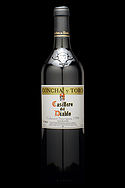
The growth of exports in 2006 was due mainly to a strong increase in sales to the United States, the Netherlands, and Japan. These three markets alone accounted for an additional U.S. $5.5 billion worth of Chilean exports. Chilean exports to the United States totaled U.S. $9.3 billion, representing a 37.7% increase compared to 2005 (U.S. $6.7 billion). Exports to the European Union were U.S. $15.4 billion, a 63.7% increased compared to 2005 (U.S. $9.4 billion). Exports to Asia increased from U.S. $15.2 billion in 2005 to U.S. $19.7 billion in 2006, a 29.9% increase.
During 2006, Chile imported U.S. $26 billion from the Americas, representing 54% of total imports, followed by Asia at 22%, and Europe at 16%. Mercosur members were the main suppliers of imports to Chile at U.S. $9.1 billion, followed by the United States with U.S. $5.5 billion and the European Union with U.S. $5.2 billion. From Asia, China was the most important exporter to Chile, with goods valued at U.S. $3.6 billion. Year-on-year growth in imports was especially strong from a number of countries—Ecuador (123.9%), Thailand (72.1%), Korea (52.6%), and China (36.9%).
Chile’s overall trade profile has traditionally been dependent upon copper exports. The state-owned firm CODELCO is the world's largest copper-producing company, with recorded copper reserves of 200 years. Chile has made efforts to expand nontraditional exports. The most important non-mineral exports are forestry and wood products, fresh fruit and processed food, fishmeal and seafood, and wine.
Successive Chilean governments have actively pursued trade-liberalizing agreements. During the 1990s, Chile signed Free Trade Agreements with Canada, Mexico, and Central America. Chile also concluded preferential trade agreements with Venezuela, Colombia, and Ecuador. An association agreement with Mercosur—Argentina, Brazil, Paraguay, and Uruguay—went into effect in October 1996. Continuing its export-oriented development strategy, Chile completed landmark free trade agreements in 2002 with the European Union and South Korea. Chile, as a member of the Asia-Pacific Economic Cooperation (APEC) organization, is seeking to boost commercial ties to Asian markets. To that end, it has signed trade agreements in recent years with New Zealand, Singapore, Brunei, India, China, and most recently Japan. In 2007, Chile plans to begin negotiations with Thailand, Malaysia, and Australia.
After two years of negotiations, the United States and Chile signed an agreement in June 2003 that will lead to completely duty-free bilateral trade within 12 years. The U.S.-Chile FTA entered into force January 1, 2004 following approval by the U.S. and Chilean congresses. The bilateral FTA has inaugurated greatly expanded U.S.-Chilean trade ties, with total bilateral trade jumping by 154% during the FTA’s first three years.
Chile unilaterally lowered its across-the-board import tariff for all countries with which it does not have a trade agreement to 6% in 2003. Higher effective tariffs are charged only on imports of wheat, wheat flour, and sugar as a result of a system of import price bands. The price bands were ruled inconsistent with Chile's World Trade Organization (WTO) obligations in 2002, and the government has introduced legislation to modify them. Under the terms of the U.S.-Chile FTA, the price bands will be completely phased out for U.S. imports of wheat, wheat flour, and sugar within 12 years.
Chile is a strong proponent of pressing ahead on negotiations for a Free Trade Area of the Americas (FTAA) and is active in the WTO’s Doha round of negotiations, principally through its membership in the G-20 and Cairns Group.
Finance
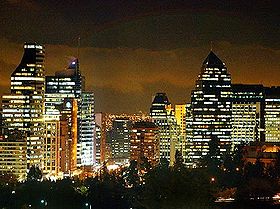
Chile's financial sector has grown quickly in recent years, with a banking reform law approved in 1997 that broadened the scope of permissible foreign activity for Chilean banks. The Chilean Government implemented a further liberalization of capital markets in 2001, and there is further pending legislation proposing further liberalization. Over the last ten years, Chileans have enjoyed the introduction of new financial tools such as home equity loans, currency futures and options, factoring, leasing, and debit cards. The introduction of these new products has also been accompanied by an increased use of traditional instruments such as loans and credit cards. Chile's private pension system, with assets worth roughly $70 billion at the end of 2006, has been an important source of investment capital for the capital market. Chile maintains one of the best credit ratings (S&P A+) in Latin America. There are three main ways for Chilean firms to raise funds abroad: bank loans, issuance of bonds, and the selling of stocks on U.S. markets through American Depository Receipts (ADRs). Nearly all of the funds raised through these means go to finance domestic Chilean investment. The government is required by law to run a fiscal surplus of at least 1% of GDP. In 2006, the Government of Chile ran a surplus of $11.3 billion, equal to almost 8% of GDP. The Government of Chile continues to pay down its foreign debt, with public debt only 3.9% of GDP at the end of 2006.
Demographics
Chile's growth has been declining since the early 1990s, due to a decreasing birthrate. By 2050 the population is expected to reach approximately 20.2 million. About 85 percent of the country's population lives in urban areas, with 40 percent living in Greater Santiago.
Racial structure
The bulk of the Chilean population are mestizo quality, descendants of colonial Spanish immigrants and Amerindian females (including the Atacameños, Diaguitas, Picunches, Araucanians or Mapuches, Huilliches, Pehuenches, and Cuncos.
Chile's ethnic structure can be classified as 30 percent white, 5 percent Native American, and 65 percent predominantly white mestizos. Whites are mostly Spanish in origin (mainly Castilians, Andalusians, and Basques), and to a much lesser degree from Chile's various waves of immigrants. The black population was always scant, reaching a high of 25,000 during the colonial period; its racial contribution is less than 1 percent. The current Native American population is relatively small (see below) according to the censuses; their numbers are augmented when one takes into consideration those that are physically similar and those that are linguistically or socially thought to belong to them.
Indigenous communities
| Those belonging to recognised indigenous communities (2002) | |||||
|---|---|---|---|---|---|
| Alacalufe | 2.622 | 0,02% | Mapuche | 604.349 | 4,00% |
| Atacameño | 21.015 | 0,14% | Quechua | 6.175 | 0,04% |
| Aymara | 48.501 | 0,32% | Rapanui | 4.647 | 0,03% |
| Colla | 3.198 | 0,02% | Yámana | 1.685 | 0,01% |
In the 1992 Chilean census, a total of 10.5% of the total population surveyed declared themselves indigenous, irrespective of whether they currently practiced or spoke a native culture and language; almost one million people (9.7% of the total) declared themselves Mapuche, 0.6% declared to be Aymara, and 0.2% reported as Rapanui.
At the 2002 census, only indigenous people that still practiced or spoke a native culture and language were surveyed: 4.6% of the population (692,192 people) fit that description; of these, 87.3% declared themselves Mapuche.
Immigration
Relative to its overall population, Chile never experienced any large-scale wave of immigrants. The total number of immigrants to Chile, both originating from other Latin American countries and all other (mostly European) countries, never surpassed 4 percent of its total population. This is not to say that immigrants were not important to the evolution of Chilean society and the Chilean nation. Basque families who migrated to Chile in the eighteenth century vitalized the economy and joined the old Castilian aristocracy to become the political elite that still dominates the country. Some non-Spanish European immigrants arrived in Chile - mainly to the northern and southern extremities of the country - during the nineteenth and twentieth centuries, including [[United Kingdom|English, Germans, Irish, Italians, French, Croatians, and other former Yugoslavians. The prevalence of non-Hispanic European surnames among the governing body of modern Chile testifies to their disproportionate contribution. Also worth mentioning are the Korean and Palestinian communities, the latter being the largest colony of that people outside of the Arab world. The volume of immigrants from neighboring countries to Chile during those same periods was similar.
During the last decade immigration to Chile has doubled, originating primarily from Argentina, Bolivia, and Peru, while emigration of Chileans has decreased.
Culture
Northern Chile was an important center of culture in the medieval and early modern Inca civilization, while the central and southern regions were areas of Mapuche cultural activity. Following their conquest and during the early Republican period, the culture was dominated by the Spanish. Other European influences, primarily English and French, began in the nineteenth century and have continued to this day.
The national dance is the cueca. Another form of traditional Chilean song, though not a dance, is the tonada. Arising from music imported by the Spanish colonists, it is distinguished from the cueca by an intermediate melodic section and a more prominent melody. In the mid-1960s native musical forms were revitalized by the Parra family with the Nueva Canción Chilena, which was associated with political activists and reformers, and by the folk singer and researcher on folklore and Chilean ethnography Margot Loyola.
Chileans call their country país de poetas (land of poets). Gabriela Mistral was the first Chilean to win a Nobel Prize for Literature (1945). Chile's most famous poet, however, is Pablo Neruda, who also won the Nobel Prize for Literature (1971) and is world renowned for his extensive works on romance, nature, and politics.
Tourism
Tourism has become one of the main sources of revenue; in 2005, tourism grew by 13.6 percent, generating more than $1.5 billion (equivalent to 1.33 percent of the national GDP).
The main attractions for tourists are places of natural beauty situated in the extreme zones of the country:
- San Pedro de Atacama, in the north, is very popular with foreign tourists who arrive to admire the Incaic architecture and the altiplano lakes of the Valley of the Moon.
- Putre, also in the north, has Chungará Lake, as well as the Parinacota and the Pomerape volcanoes, with altitudes of 6,348 m and 6,222 m, respectively. * Throughout the central Andes there are many ski resorts of international repute.
- In the south, the main tourist sites are Chiloé island, Patagonia, the San Rafael Lagoon, with its many glaciers, and the Towers of Paine national park.
- The central port city of Valparaíso, with its unique architecture, is also popular. Due to its proximity to Santiago, the coast of the Valparaíso Region, with its many beach resorts, receives the largest amount of local tourists.
- Easter Island in the Pacific Ocean is probably the main Chilean tourist destination.
- Viña del Mar, Valparaíso's northern affluent neighbor, is popular due to its beaches, casino, and its annual song festival, the most important musical event in Latin America.
Language
The official language is Spanish, though it is difficult for foreigners to understand due to the dropping of final syllables and 's' sounds, the very soft pronunciation of some consonants, and the high levels of slang employed, particularly in Santiago and the surrounding areas. Chileans also tend to speak much faster than natives of neighboring countries.
Religion
Chile is a traditionally Roman Catholic nation, with an estimated 70 percent of Chileans belonging to that church. Other denominations or groupings include: Protestant or evangelical (15.1%), Jehovah's Witnesses (1%), the Church of Jesus Christ of Latter-day Saints (0.9%), Jewish (0.1%), atheist or agnostic (8.3%), and other (4.4%). Less than 0.1% are either Orthodox or Muslim.
ReferencesISBN links support NWE through referral fees
- ↑ El Mercurio. Casen Study [1]
- ↑ The Economist. Destitute no more [2]
- ↑ "Human Development Report 2006," United Nations Development Programme, p. 335, November 9 2006
Sources and Further reading
- Rector, John. 2003. The History of Chile. Westport, CT: Greenwood Press. ISBN 0313317593
- [4] Background Notes: Chile, Department of State, Retrieved November 10, 2007.
- [5] Library of Congress Country Profile
- Encyclopaedia Britannica, Chile - Country Page
- [6] CIA World Factbook
External links
Official
- Gobierno - Government ([7] (Spanish)
- Presidencia - Presidency (English version)
- Ministerio del Interior - Interior Ministry
- Ministerio de Relaciones Exteriores - Ministry of Foreign Affairs
- Ministerio de Hacienda - Ministry of Finance (English version)
- Congreso Nacional - National Congress
- Senado - Senate
- Cámara de Diputados - Chamber of Deputies
- Biblioteca del Congreso Nacional - Library of National Congress
- Poder Judicial - Judiciary
- Banco Central - Central Bank (English version)
- Instituto Nacional de Estadísticas (INE) - National Statistics Institute
General information
- Atacama Chile
- Open Directory Project - Chile directory category
- Chile Information, Travel, Living Abroad, Human Rights & Environment Chile Information Project
- Chile News Santiago Times
- [8] Latin American Network (Information Center)
- [9] Council of Hemispheric Affairs.
- Invest in Chile Chilean Government
- [10] Native flora species
Credits
New World Encyclopedia writers and editors rewrote and completed the Wikipedia article in accordance with New World Encyclopedia standards. This article abides by terms of the Creative Commons CC-by-sa 3.0 License (CC-by-sa), which may be used and disseminated with proper attribution. Credit is due under the terms of this license that can reference both the New World Encyclopedia contributors and the selfless volunteer contributors of the Wikimedia Foundation. To cite this article click here for a list of acceptable citing formats.The history of earlier contributions by wikipedians is accessible to researchers here:
The history of this article since it was imported to New World Encyclopedia:
Note: Some restrictions may apply to use of individual images which are separately licensed.


